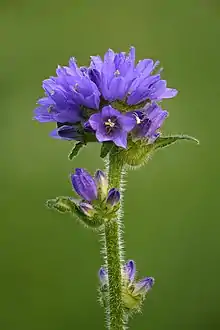| Campanula cervicaria | |
|---|---|
 | |
| Scientific classification | |
| Kingdom: | Plantae |
| Clade: | Tracheophytes |
| Clade: | Angiosperms |
| Clade: | Eudicots |
| Clade: | Asterids |
| Order: | Asterales |
| Family: | Campanulaceae |
| Genus: | Campanula |
| Species: | C. cervicaria |
| Binomial name | |
| Campanula cervicaria | |
| Synonyms | |
|
Many; see Wikispecies | |
Campanula cervicaria, the bristly bellflower,[1] is a species of flowering plant in the bellflower family Campanulaceae. The plant is roughly hairy and the flowers are about 1–2 centimetres (0.4–0.8 in) long, light blue and are grouped together.[2]
Description
Bristly bell flower is a biennial or short-lived perennial herbaceous plant growing to a height of 30 to 100 centimetres (12 to 39 in). In its first year, this plant produces a rosette of lanceolate, spatulate leaves with winged stalks. In the second year it sends up one or more erect flowering stems with squarish edges and roughly hairy. The leaves on these are alternate, linear to narrow lanceolate bristly and unstalked. The leaf blades are undulating and the margins have rounded teeth. The lower leaves wither away when the plant is flowering. The inflorescence forms a dense terminal cluster and further smaller clusters grow from the upper leaf axils. The calyx of each flower is fused and has five blunt lobes. The corolla is five-lobed, 12 to 20 mm (0.5 to 0.8 in) long with five pale blue (or occasionally white) fused petals. The corolla lobes are longer than they are wide. There are five stamens and a pistil formed from three fused carpels. The fruit is a strongly veined, narrowly conical, nodding capsule. The flowering period is from June to September.[3]
Distribution and habitat
Bristly bell flower is native to Scandinavia and Central Europe. It has become naturalised in Lake and St. Louis counties of Minnesota, but not in other parts of North America. [4] Its natural habitat is woodland edges, hillside meadows, dry meadows and banks. It also flourishes in places where the soil has been disturbed such as after slash-and-burn, or after forest clearance or when coppicing has taken place.[3]
References
- ↑ Schauer, Thomas (1982). A Field Guide to the Wild Flowers of Britain and Europe, William Collins, London, Glasgow, Sydney, Auckland, Toronto, Johannesburg, p. 192. ISBN 978-0-00-219257-6.
- ↑ Anderberg, Arne; Anderberg, Anna-Lena. "Campanula cervicaria". Den virtuella floran (in Swedish). Swedish Museum of Natural History. Retrieved 27 November 2010.
- 1 2 "Bristly Bellflower: Campanula cervicaria". NatureGate. Retrieved 2013-12-31.
- ↑ "Campanula cervicaria (Bristly Bellflower)". Minnesota Wildflowers. Retrieved 2013-12-31.
External links
 Media related to Campanula cervicaria at Wikimedia Commons
Media related to Campanula cervicaria at Wikimedia Commons Data related to Campanula cervicaria at Wikispecies
Data related to Campanula cervicaria at Wikispecies